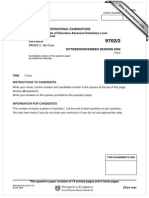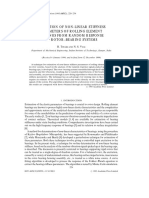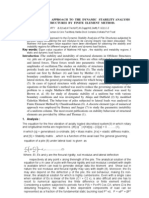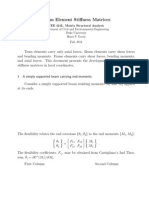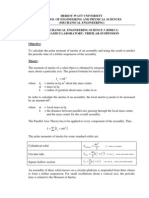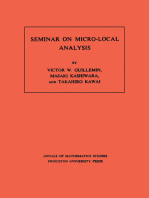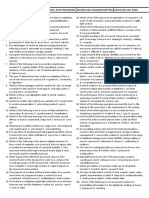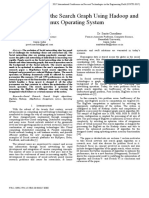Symbolic Analysis of Continuous Beams: Husain Jubran Al-Gahtani
Symbolic Analysis of Continuous Beams: Husain Jubran Al-Gahtani
Uploaded by
Sç-č AbabiiCopyright:
Available Formats
Symbolic Analysis of Continuous Beams: Husain Jubran Al-Gahtani
Symbolic Analysis of Continuous Beams: Husain Jubran Al-Gahtani
Uploaded by
Sç-č AbabiiOriginal Title
Copyright
Available Formats
Share this document
Did you find this document useful?
Is this content inappropriate?
Copyright:
Available Formats
Symbolic Analysis of Continuous Beams: Husain Jubran Al-Gahtani
Symbolic Analysis of Continuous Beams: Husain Jubran Al-Gahtani
Uploaded by
Sç-č AbabiiCopyright:
Available Formats
Symbolic analysis of continuous beams
Husain Jubran Al-Gahtani Associate Professor, Civil Engineering Department, Box 800, KFUPM, Dhahran 31261, Saudi Arabia E-mail: hqahtani@kfupm.edu.sa
Abstract The study presents a direct method for obtaining symbolic solutions for continuous beams. The external applied concentrated forces, distributed forces and moment couples are represented by step/singular functions. The integration of the governing differential equation and the solution of the boundary and support conditions are performed using Mathematica. The output of the code produces closed-form symbolic solutions for the beam deection and its derivatives, as well as all support reactions and moments. Several examples are presented to illustrate the capability of the proposed procedure. Keywords continuous beam; symbolic computation; computer algebra; Mathematica
Introduction Symbolic computation or computer algebra has attracted many researchers in recent years [14]. Examples of the new computer packages performing these computations are Mathematica, Maple, and Macsyma. Unlike traditional computer programs, which perform only numerical computations, these packages have the remarkable capability of manipulating numerical, symbolic and graphical computations. Although, computer-algebra systems have been in existence since 1953 [1], their usage has been restricted to the research of specialist groups and, moreover, their extensive memory required large mainframe computers at that time. Due to the emergence of relatively inexpensive, yet powerful, personal computers, the use of computer-algebra systems has become popular and more widespread. It is the purpose of this paper to demonstrate the efciency of one of these computer packages, namely Mathematica [5] to obtain symbolic analyses for continuous beams. Governing equations Consider an n-span continuous beam with n 1 intermediate supports, as shown in Fig. 1. EI y IV = Qi 1( x xqi1 ) + Qi 1( x xqi2 ) Pi 0 ( x xpi ) +
i =1 i =1 i =1 Nq Nq Np
R ( x xr )
0 i i i =1
n 1
(1)
where EI is the beam stiffness, y is the deection, Qi is the uniform force acting over 2 the interval xq1 i < x < xqi , Pi is the concentrated force applied at x = xpi, Ri is the
International Journal of Mechanical Engineering Education 36/1
70
H. J. Al-Gahtani
xmi xqi2 xqi1 xpi Pi
Fixed pinned or free
Qi
Mi
Fixed pinned or free
R0
R1 xri
....
L
Ri
....
Rn1
Rn
Fig. 1
General continuous beam.
support reaction at x = xri , Nq is the number of uniform forces and Np is the number of concentrated forces. The singular functions 0 and 1 are dened by: x > {1 0 x< x= ( x ) = { 0 x 1( x ) =
0
(2) (3)
Integrating equation 1 four times, we get the shear force, V(x), the bending moment, M(x), the slope, s(x), and the deection y(x): V ( x ) = EI y = Qi ( x xqi1 ) 1( x xqi1 ) + Qi ( x xqi2 ) 1( x xqi2 )
i =1 i =1 Nq Nq
Pi ( x xpi ) + Ri ( x xri ) + C1
1 1 i =1 i =1
Np
n 1
(4)
M ( x ) = EI y =
Np
1 1 q 2 2 Qi ( x xqi1 ) 1( x xqi ) + Qi ( x xqi2 ) 1( x xqi2 ) 2 i =1 2 i =1
n 1 i =1
Nq
Pi ( x xpi ) 1( x xpi ) + Ri ( x xri ) 1( x xri ) +
i =1
(5)
M ( x xm ) + C
1 i i i =1 N
Nm
s ( x) = y =
N
1 1 q 1 q 3 3 Qi ( x xqi1 ) 1( x xqi ) + Qi ( x xqi2 ) 1( x xqi2 ) 6 i =1 EI 6 i =1
1 p 1 n 1 2 1 ( ( ) ) P x xp x xp + i i i Ri ( x xri )2 1( x xri ) + 2 i =1 2 i =1 +C M ( x xm ) ( x xm )
1 i i i i =1 Nm
(6)
International Journal of Mechanical Engineering Education 36/1
Symbolic analysis of continuous beams
71
N
y ( x) =
1 1 q 1 q 4 4 Qi ( x xqi1 ) 1( x xqi ) + Qi ( x xqi2 ) 1( x xqi2 ) 24 i =1 EI 24 i =1 1 p 1 n 1 3 3 Pi ( x xpi ) 1( x xpi ) + Ri ( x xri ) 1( x xri ) + 6 i =1 6 i =1
N
(7)
1 Nm + C4 Mi ( x xmi )2 1( x xmi ) 2 i =1
It should be noted that if EI is not constant, then the expressions for s(x) and y(x) become: s ( x ) = y = M ( x) dx EI ( x ) (8) (9)
y ( x ) = s ( x ) dx
In order to carry out symbolic integration, the powerful symbolic package Mathematica is utilized. The four constants C1, C2, C3, C4 and the n 1 support reactions, Ri, can be determined by using the expressions for y and its proper derivatives to satisfy four end conditions (two per end) and forcing y to be zero at the n 1 supports. Once these unknowns are determined, the solution y and its derivatives can be obtained in terms of the above singular functions. In order to illustrate the procedure, three examples are considered. Examples Example 1 Let us consider a continuous beam xed at its ends, resting on n 1 equally spaced intermediate supports and subjected to a uniform load, Q0. The results for the support reactions and moments are given in Tables 1 and 2, respectively. The results can be generalized as follows: R0 = Rn = Q0 ( L n ) 2
TABLE 1 Support reactions for the continuous beam with xed ends
n Support reactions/(Q0L) R0 1/2 1/4 1/6 ... 1/2n R1 1/2 1/2 1/3 ... 1/n R2 1/4 1/3 ... 1/n R3 1/6 ... 1/n ... ... 1/n Rn ... 1/2n
(10)
1 2 3 ... n
International Journal of Mechanical Engineering Education 36/1
72
H. J. Al-Gahtani
TABLE 2
Support moments for the continuous beam with xed ends
Support moments/(Q0L2) n 1 2 3 ... n M0 1/12 1/48 1/108 ... 1/12n2 M1 1/12 1/48 1/108 ... 1/12n2 M2 1/48 1/108 ... 1/12n2 M3 1/108 ... 1/12n2 ... ... 1/12n2 Mn ... 1/12n2
TABLE 3
Support reactions for the continuous beam with simply supported ends
Support reactions/(Q0L/n)
R0
R1
R2
R3
R4
R5
R6
R7
R8 153/388 601/530 349/362
R9 209/530 821/724
R10 571/1448
1 1/2 1/2 2 3/8 5/4 3/8 3 2/5 11/10 11/10 2/5 4 11/28 8/7 13/14 8/7 11/28 5 15/38 43/38 37/38 37/38 43/38 15/38 6 41/104 59/52 25/26 53/52 25/26 59/52 41/104 7 28/71 161/142 137/142 143/142 143/142 137/142 161/142 28/71 8 153/388 110/97 187/194 98/97 193/194 98/97 187/194 110/97 9 209/530 601/530 511/530 107/106 529/530 529/530 107/106 511/530 10 571/1448 821/724 349/362 731/724 361/362 725/724 361/362 731/724
Ri = Q0 ( L i ) , i = 1, 2, . . . , n 1 Mi = Q0 ( L n ) , i = 1, 2, . . . , n 1 12
2
(11) (12)
It is interesting to note that the values of the support reactions and moments are xed functions of the span length (L/n). Other quantities, such as mid-span moments and deections, can be easily obtained from equilibrium. Example 2 Let us repeat example 1 for the case of simply supported ends. The results for this case are obtained for n = 1, 2, . . . , 10, as given in Tables 3 and 4. Unlike the xedends case, all support reactions and moments are not xed functions of (L/n). However, these quantities converge to limiting values as n increases. As an example, each of the end reactions, R0 and Rn, converges to a value of 0.394338 Q0L/n, as shown in Fig. 2. The same thing can be said about reactions and moments at internal supports.
International Journal of Mechanical Engineering Education 36/1
Symbolic analysis of continuous beams
73
TABLE 4 Support moments for the continuous beam with simply supported ends
Support moments / (Q0L2/n2) n M1 M2 M3 M4 M5 M6 M7 M8 M9
2 1/8 3 1/10 4 3/28 5 2/19 6 11/104 7 15/142 8 41/38 9 28/265 10 153/1448
1/10 1/14 3/28 3/38 3/38 2/19 1/13 9/104 1/13 11/104 11/142 6/71 6/71 11/142 15/142 15/194 33/388 8/97 33/388 15/194 41/388 41/530 9/106 22/265 22/265 9/106 41/530 28/265 14/181 123/1448 15/181 121/1448 15/181 123/1448 14/181 153/1448
0.405 0.4 0.395
0.394338
0.39 0.385
R0 , Rn / (Q0L/n)
0.38 0.375 0.37 2 4 6
Odd n Even n
10
Fig. 2
End support reaction versus number of spans of pinned continuous beam.
Example 3 This example demonstrates the computational and graphical capabilities of Mathematica to generate inuence lines for continuous beams. Consider the ve-span continuous beam shown in Fig. 3. Inuence lines for various quantities can be obtained by using the above procedure for obtaining symbolic solutions for a unit load located at a variable distance along the beam. The inuence lines for negative moments at the supports and positive moments at the mid-spans are given in Figs 4
International Journal of Mechanical Engineering Education 36/1
74
H. J. Al-Gahtani
B A L C
D E L
F G L
H I L
J K L
Fig. 3
Five-span beam subjected to a moving unit load.
MC/L
/L
(a)
ME/L /L
(b)
Fig. 4
Inuence lines for negative moments: (a) moment at the second support (x/L = 1); (b) moment at the third support (x/L = 2).
and 5, respectively. Their maximum values and the corresponding locations of the unit load are given in Table 5. Conclusion The present study presents a simple yet efcient procedure for obtaining symbolic solutions for continuous beams. Such symbolic solutions are very useful
International Journal of Mechanical Engineering Education 36/1
Symbolic analysis of continuous beams
75
MB/L
(a)
/L
MD/L
(b)
/L
MF/L
(c)
/L
Fig. 5 Inuence lines for positive moments: (a) moment at the middle of the rst span (x/L = 1/2); (b) moment at the middle of the second span (x/L= 3/2); (c) moment at the middle of the third span (x/L = 5/>).
for parametric studies and structural design optimization. It should be noted that the procedure is valid for any support conditions and load conguration. The number of spans, n, can be as high as desired, provided that the available computer memory is adequate. The procedure can be extended easily to continuous frames and similar problems.
International Journal of Mechanical Engineering Education 36/1
76
H. J. Al-Gahtani
TABLE 5
Moment MB MC MD ME MF
Maximum positive and negative moments
Location of unit load z/L 1/2 1 3 3/2 1 (57 39 ) 15 5/2
Maximum value Mmax/(Q0L2/n2) 167 836 112 627 3 289 1672 2 ( 54 + 13 39 ) 3135 13 76
Acknowledgement The author would like to express his appreciation to King Fahd University of Pertoleum & Minerals (KFUPM) for its support. References
[1] A. I. Beltzer, Variational and Finite Element Methods: A Symbolic Computation Approach (Springer, Berlin, 1990). [2] R. Julio, et al., The impulse response in the symbolic computing of modes for beams and plates, Applied Numerical Mathematics, 40(1) (2002), 119135. [3] M. N. Pavlovic, Bending of clamped orthotropic rectangular plates: a variational symbolic solution, Computers and Structures, 77(2) (2003), 117128. [4] M. N. Pavlovic, Symbolic computation in structural engineering, Computers and Structures, 81(22 23) (2003), 21212136. [5] S. Wolfram, Mathematica: A System for Doing Mathematics by Computer, 2nd edition (Addison Wesley, New York, 1991).
International Journal of Mechanical Engineering Education 36/1
You might also like
- Rayleigh Ritz MethodDocument7 pagesRayleigh Ritz Methodrameshbabu_197963% (8)
- ENSC3001 - Exam NotesDocument13 pagesENSC3001 - Exam NotesGeoffreyWanNo ratings yet
- USRP DocumentationDocument90 pagesUSRP DocumentationFiras Abbas Hamza100% (10)
- Inverse Kinematics Problem (Ikp) of 6-Dof Manipulator by Locally Recurrent Neural Networks (LRNNS)Document5 pagesInverse Kinematics Problem (Ikp) of 6-Dof Manipulator by Locally Recurrent Neural Networks (LRNNS)yousif al mashhadanyNo ratings yet
- NoncgearDocument6 pagesNoncgearAndreea UdreaNo ratings yet
- Response Spectrum Analysis PDFDocument30 pagesResponse Spectrum Analysis PDFSujay Santra100% (1)
- Mechanical Engineering Full Paper 2006Document20 pagesMechanical Engineering Full Paper 2006Raghib ShakeelNo ratings yet
- Structural DynamicsDocument110 pagesStructural DynamicsJaga Nath75% (4)
- Are You Ready For SMT359Document8 pagesAre You Ready For SMT359nuphormNo ratings yet
- Buckled Beam Nonlinear VibrationDocument10 pagesBuckled Beam Nonlinear Vibrationhmsedighi459No ratings yet
- ControlofaNonlinearandLinearizedModelofSelf balancingElectricMotorcycle PDFDocument13 pagesControlofaNonlinearandLinearizedModelofSelf balancingElectricMotorcycle PDFPhương Hoàng VănNo ratings yet
- Selective Harmonic Elimination Switching Strategy For Back To-Back Stacked Multicell ConverterDocument10 pagesSelective Harmonic Elimination Switching Strategy For Back To-Back Stacked Multicell ConverterIAEME PublicationNo ratings yet
- CHEM F111 General Chemistry Quantum Description of Some Simple SystemsDocument25 pagesCHEM F111 General Chemistry Quantum Description of Some Simple SystemsclicksaswatNo ratings yet
- Truss MathematicsDocument8 pagesTruss MathematicsOladunni Afolabi100% (1)
- Dimensional AnalysisDocument13 pagesDimensional AnalysisahmedyasharNo ratings yet
- 9702 w02 QP 2Document16 pages9702 w02 QP 2Farhad AliNo ratings yet
- Analysis of A Rectangular Waveguide Using Finite Element MethodDocument9 pagesAnalysis of A Rectangular Waveguide Using Finite Element MethodV'nod Rathode BNo ratings yet
- L7 - Engineering Method For Dynamic AeroelasticityDocument19 pagesL7 - Engineering Method For Dynamic AeroelasticityAbaziz Mousa OutlawZz100% (1)
- Solution Report 2Document7 pagesSolution Report 2dhawalNo ratings yet
- Truss Matlab Mef StifnessDocument8 pagesTruss Matlab Mef StifnessAoun Omar100% (1)
- Tiwari - Non Linear Stiffness Bearing ParametersDocument11 pagesTiwari - Non Linear Stiffness Bearing Parameterssimone.castagnettiNo ratings yet
- Okonkwo, V.O., Aginam, C.H., and Chidolue, C. ADocument9 pagesOkonkwo, V.O., Aginam, C.H., and Chidolue, C. AOscar ChappilliquénNo ratings yet
- FIR 05 Dynamics PDFDocument65 pagesFIR 05 Dynamics PDFselvamNo ratings yet
- Nonlinear Vibrations of A Buckled Beam Under Harmonic ExcitationDocument10 pagesNonlinear Vibrations of A Buckled Beam Under Harmonic ExcitationRobinson MartinezNo ratings yet
- sns_lab_8Document11 pagessns_lab_8ahmadnasir409959No ratings yet
- Derivation of The Constants of The Motion For Central ForcesDocument6 pagesDerivation of The Constants of The Motion For Central ForcesEpic WinNo ratings yet
- Elementary Tutorial: Fundamentals of Linear VibrationsDocument51 pagesElementary Tutorial: Fundamentals of Linear VibrationsfujinyuanNo ratings yet
- Loop MultiDocument52 pagesLoop MultiTrung PhanNo ratings yet
- Yagi Uda AntennaDocument33 pagesYagi Uda AntennaGayathri RamasankarNo ratings yet
- Fem ViberationDocument18 pagesFem Viberationsaqlain05No ratings yet
- Unitary Transforms: Borrowed From UMD ENEE631 Spring'04Document32 pagesUnitary Transforms: Borrowed From UMD ENEE631 Spring'04Abishek PonrajNo ratings yet
- Some Stochastic Modelling Techniques and Their ApplicationsDocument5 pagesSome Stochastic Modelling Techniques and Their ApplicationsTrần Nhật AnhNo ratings yet
- Lecture 16Document26 pagesLecture 16Pranjal BatraNo ratings yet
- String Dynamics 5&6 2015Document35 pagesString Dynamics 5&6 2015Feeling_so_flyNo ratings yet
- Electrical Transient PDFDocument6 pagesElectrical Transient PDFalexwoodwickNo ratings yet
- Lecture 2Document25 pagesLecture 2Balaji KannanNo ratings yet
- Introduction:The Stability and Instability of Structural Elements in Offshore StructuresDocument6 pagesIntroduction:The Stability and Instability of Structural Elements in Offshore Structuressudipta_chakraborty_78No ratings yet
- Beam Element Stiffness MatricesDocument9 pagesBeam Element Stiffness MatricessenthilcivilNo ratings yet
- Radial Fingering in A Hele-Shaw Cell: Ladhyx Internship Report, October 3 - December 23, 2011Document31 pagesRadial Fingering in A Hele-Shaw Cell: Ladhyx Internship Report, October 3 - December 23, 2011okochaflyNo ratings yet
- 27 Diagnosis of Gear Faults by CyclostationarityDocument7 pages27 Diagnosis of Gear Faults by CyclostationarityAbdelkader RabahNo ratings yet
- Discrete-Time Nonlinear Sliding Mode Controller: Nikhil Kumar Yadav, R.K. SinghDocument7 pagesDiscrete-Time Nonlinear Sliding Mode Controller: Nikhil Kumar Yadav, R.K. SinghHamza MasreNo ratings yet
- Physics: Paper 2 As CoreDocument16 pagesPhysics: Paper 2 As CoreYaseenTamerNo ratings yet
- Trifilar Suspension 1Document4 pagesTrifilar Suspension 1Ninad BhanuNo ratings yet
- Application of Differential Transform Method in Free Vibration Analysis of Rotating Non-Prismatic BeamsDocument8 pagesApplication of Differential Transform Method in Free Vibration Analysis of Rotating Non-Prismatic BeamsKhairul Anuar RahmanNo ratings yet
- Wan 2013Document5 pagesWan 2013upendrauppari79No ratings yet
- Student Solutions Manual to Accompany Economic Dynamics in Discrete Time, second editionFrom EverandStudent Solutions Manual to Accompany Economic Dynamics in Discrete Time, second editionRating: 4.5 out of 5 stars4.5/5 (2)
- Application of Derivatives Tangents and Normals (Calculus) Mathematics E-Book For Public ExamsFrom EverandApplication of Derivatives Tangents and Normals (Calculus) Mathematics E-Book For Public ExamsRating: 5 out of 5 stars5/5 (1)
- Robot Manipulators: Modeling, Performance Analysis and ControlFrom EverandRobot Manipulators: Modeling, Performance Analysis and ControlNo ratings yet
- Logical progression of twelve double binary tables of physical-mathematical elements correlated with scientific-philosophical as well as metaphysical key concepts evidencing the dually four-dimensional basic structure of the universeFrom EverandLogical progression of twelve double binary tables of physical-mathematical elements correlated with scientific-philosophical as well as metaphysical key concepts evidencing the dually four-dimensional basic structure of the universeNo ratings yet
- Mathematics 1St First Order Linear Differential Equations 2Nd Second Order Linear Differential Equations Laplace Fourier Bessel MathematicsFrom EverandMathematics 1St First Order Linear Differential Equations 2Nd Second Order Linear Differential Equations Laplace Fourier Bessel MathematicsNo ratings yet
- Finite Elements for Truss and Frame Structures: An Introduction Based on the Computer Algebra System MaximaFrom EverandFinite Elements for Truss and Frame Structures: An Introduction Based on the Computer Algebra System MaximaNo ratings yet
- Green's Function Estimates for Lattice Schrödinger Operators and ApplicationsFrom EverandGreen's Function Estimates for Lattice Schrödinger Operators and ApplicationsNo ratings yet
- rADINA Elnotes - 94Document33 pagesrADINA Elnotes - 94Sç-č AbabiiNo ratings yet
- General Formula For Bi-Aspheric Singlet Lens Design Free of Spherical AberrationDocument5 pagesGeneral Formula For Bi-Aspheric Singlet Lens Design Free of Spherical AberrationSç-č AbabiiNo ratings yet
- What Are Your Areas For Improvement and How Will You Work On Them?Document1 pageWhat Are Your Areas For Improvement and How Will You Work On Them?Sç-č AbabiiNo ratings yet
- Hexahedral Element General EquationsDocument9 pagesHexahedral Element General EquationsSç-č AbabiiNo ratings yet
- Tikz Library For Structural Analysis: Stanli User Guide, Version 3.0 J Urgen HacklDocument58 pagesTikz Library For Structural Analysis: Stanli User Guide, Version 3.0 J Urgen HacklSç-č AbabiiNo ratings yet
- The Generalized Finite Element Method Applied To Free Vibration of Framed StructuresDocument27 pagesThe Generalized Finite Element Method Applied To Free Vibration of Framed StructuresSç-č AbabiiNo ratings yet
- C-A Coulomb BmatterDocument14 pagesC-A Coulomb BmatterSç-č AbabiiNo ratings yet
- 9th Int Bridge Man ConferenceDocument440 pages9th Int Bridge Man ConferenceLaurentiu PavelescuNo ratings yet
- ReviewDocument58 pagesReviewSç-č AbabiiNo ratings yet
- ANSYS Explicit R13 PDFDocument4 pagesANSYS Explicit R13 PDFSç-č AbabiiNo ratings yet
- Bending Moment in The Continuous Beam: Before and After RedistributionDocument1 pageBending Moment in The Continuous Beam: Before and After RedistributionSç-č AbabiiNo ratings yet
- PSIT303c: Cloud Management M. SC (Information Technology) Semester - IIIDocument1 pagePSIT303c: Cloud Management M. SC (Information Technology) Semester - IIIjohn doeNo ratings yet
- ARISE AWAKE-Rashmi Bansal PDFDocument409 pagesARISE AWAKE-Rashmi Bansal PDFHemamaliniNo ratings yet
- SS3 Data Processing Pre-WAEC ExaminationDocument3 pagesSS3 Data Processing Pre-WAEC ExaminationEjiro Ndifereke80% (5)
- Unexpected Text/Html Contenttype in Sap Cloud Platform Integration Message Using Soap AdapterDocument2 pagesUnexpected Text/Html Contenttype in Sap Cloud Platform Integration Message Using Soap Adapterpeixe.sanguebomNo ratings yet
- WSF: An HTTP-level Firewall For Hardening Web Servers: Threat ModelDocument6 pagesWSF: An HTTP-level Firewall For Hardening Web Servers: Threat ModeltestNo ratings yet
- Boot KeyDocument7 pagesBoot Keyradikaz0% (1)
- Ds-2Cd2T26G2-2I/4I Acusense 2 MP Ir Fixed Bullet Network CameraDocument5 pagesDs-2Cd2T26G2-2I/4I Acusense 2 MP Ir Fixed Bullet Network CameraFrancisco ArauzNo ratings yet
- Eaton 9395 550kVA Installation Manual 164201701Document220 pagesEaton 9395 550kVA Installation Manual 164201701Tưởng VũNo ratings yet
- Chapter4 SoundDocument35 pagesChapter4 SoundNik Muhammad Afiq AzlanNo ratings yet
- EDPMS User Manual GuideDocument34 pagesEDPMS User Manual GuideColleen Ariel SandovalNo ratings yet
- Meraki Support Stage 1Document3 pagesMeraki Support Stage 1Clark TangNo ratings yet
- ARTC 4G 5G Remote Integration MOP PA10Document32 pagesARTC 4G 5G Remote Integration MOP PA10Sanjay TanwarNo ratings yet
- Document Hw4Document12 pagesDocument Hw4kalyan.427656No ratings yet
- Karla Jennings - The Devouring FungusDocument244 pagesKarla Jennings - The Devouring Fungush0ryNo ratings yet
- CV 3Document1 pageCV 3Ashuram KumharNo ratings yet
- Indian Matka Online Tips, Best Satta Matka ResultDocument8 pagesIndian Matka Online Tips, Best Satta Matka ResultMatka IndianNo ratings yet
- Antivirus Artifacts IiiDocument44 pagesAntivirus Artifacts IiiJustinNo ratings yet
- Object Oriented Programming Using C++: ETCS-258Document27 pagesObject Oriented Programming Using C++: ETCS-258nin culusNo ratings yet
- PS3 SNES9x READMEDocument20 pagesPS3 SNES9x READMEMogale ScoopNo ratings yet
- Math 132 Master SyllabusDocument2 pagesMath 132 Master Syllabushassaniqbal84No ratings yet
- Computer Graphics Group Assignment 2Document21 pagesComputer Graphics Group Assignment 2klli234adNo ratings yet
- chatGPT Prompt EngineeringDocument11 pageschatGPT Prompt EngineeringYonas BelaynehNo ratings yet
- Optimization of The Search Graph Using Hadoop and Linux Operating SystemDocument6 pagesOptimization of The Search Graph Using Hadoop and Linux Operating SystemSamir AjaniNo ratings yet
- Abe Joseph Project Final WorkDocument49 pagesAbe Joseph Project Final WorkAbe JosephNo ratings yet
- Prgramming 9A0-409 ACE Practice Test - Updated 2018Document6 pagesPrgramming 9A0-409 ACE Practice Test - Updated 2018Pass4leads ExamNo ratings yet
- SSP AppendDocument326 pagesSSP AppendKamapantula SrinivasNo ratings yet
- Microsoft Office 365 PlansDocument13 pagesMicrosoft Office 365 PlansmusirlNo ratings yet
- Question and AnswerDocument6 pagesQuestion and Answereliza marie luisNo ratings yet
- TR-MR-HR Questions in TCS InterviewDocument10 pagesTR-MR-HR Questions in TCS Interviewamanshaik393No ratings yet















